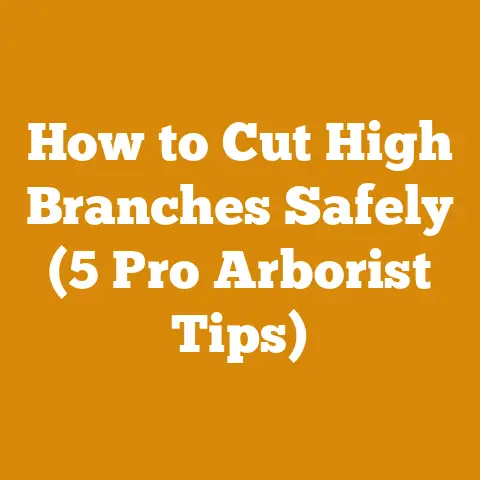Homemade Tree Climbing Spikes (5 Essential Arborist Tips)
The crisp autumn air bites at my cheeks as I stand at the base of a towering oak, its branches reaching skyward like gnarled fingers. The leaves, a vibrant tapestry of red and gold, whisper secrets in the wind – secrets only an arborist, a climber, can truly understand. For years, I’ve scaled trees like this, not just to prune or remove them, but to connect with them, to understand their architecture from the inside out. And while the market offers a plethora of commercially made tree climbing spikes, there’s a certain satisfaction, a deeper connection, that comes from crafting your own. It’s a skill passed down through generations, a blend of blacksmithing, ingenuity, and a healthy respect for gravity.
But building your own tree climbing spikes isn’t just about saving money or flexing your DIY muscles. It’s about understanding the tool intimately, knowing its strengths and limitations, and ultimately, enhancing your safety and efficiency in the trees. It’s also about customization – tailoring the spikes to your specific climbing style and the type of trees you typically work with.
Homemade Tree Climbing Spikes: 5 Essential Arborist Tips
Before you even think about heating steel or bending metal, there are critical considerations that can make or break your project – and potentially your bones. These five essential arborist tips are non-negotiable for anyone considering crafting their own tree climbing spikes.
1. Prioritize Safety Above All Else: The Unbreakable Rule
This isn’t just a tip; it’s the bedrock of everything we do as arborists. Tree climbing is inherently dangerous, and homemade equipment amplifies that risk exponentially. I can’t stress this enough: never compromise safety for cost savings or convenience.
- Understanding the Risks: Climbing spikes, or gaffs, as they’re sometimes called, are designed to penetrate the bark and cambium layer of a tree, providing a secure foothold. A failure of the spike – whether due to poor design, weak materials, or improper use – can result in a fall, leading to serious injury or even death. According to the Tree Care Industry Association (TCIA), falls are a leading cause of injury and fatality in the arboriculture industry.
- The Importance of Professional Inspection: Even if you’re confident in your fabrication skills, have your homemade spikes inspected by a qualified arborist or a professional who specializes in metal fabrication and understands the stresses involved in tree climbing. A fresh pair of eyes can spot potential weaknesses you might have missed.
- The “Drop Test” – A Necessary Evil: Before trusting your life to your homemade spikes, subject them to rigorous testing. This includes a “drop test” where you simulate the force of a fall onto the spikes. Secure the spikes to a sturdy structure and apply increasing amounts of weight. Look for any signs of bending, cracking, or deformation. This is where you separate the good from the potentially disastrous.
- Personal Story: I once witnessed a seasoned arborist, known for his meticulous craftsmanship, test a set of homemade spikes by suspending a sandbag weighing nearly 300 pounds from them. To his dismay, one of the spikes began to bend under the load. He scrapped the entire set and went back to the drawing board. That incident hammered home the importance of rigorous testing.
- Always Wear Appropriate Safety Gear: This seems obvious, but it’s worth reiterating. A properly fitted climbing harness, a helmet, and safety glasses are non-negotiable. Consider using a lanyard and rope system as a backup.
- Statistics and Data: A study by the National Institute for Occupational Safety and Health (NIOSH) found that wearing a helmet reduces the risk of head injury by 85% in tree-related accidents. Don’t become a statistic.
Actionable Steps:
- Before starting your project, research and understand the forces involved in tree climbing.
- Consult with experienced arborists and metal fabricators.
- Subject your homemade spikes to rigorous testing, including a drop test.
- Always wear appropriate safety gear when using tree climbing spikes.
2. Design Matters: Mimicking and Improving on the Best
The design of your tree climbing spikes is paramount. You can’t just weld a piece of metal to your boot and call it a day. The shape, angle, and length of the spike all contribute to its effectiveness and safety.
- Studying Existing Designs: Before you even start sketching, thoroughly research commercially available tree climbing spikes. Examine their design features, paying attention to the angle of the spike, the width of the shank, and the method of attachment to the boot. Companies like Buckingham and Weaver are industry leaders, and their designs are a good starting point.
- Understanding Spike Geometry: The angle of the spike is crucial for penetration and holding power. A steeper angle provides better penetration but can be more prone to slipping. A shallower angle provides better holding power but may require more force to penetrate the bark. The optimal angle is a balance between these two factors.
- The Importance of Shank Design: The shank is the part of the spike that connects to the boot. It needs to be strong enough to withstand the forces of climbing and provide a secure connection to the boot. Consider using a reinforced shank design to prevent bending or breakage.
- Customization for Tree Species: Different tree species have different bark thicknesses and densities. If you primarily work with a specific type of tree, you may need to adjust the design of your spikes accordingly. For example, climbing softwoods like pine may require a longer, thinner spike than climbing hardwoods like oak.
- Ergonomics and Comfort: Don’t overlook the importance of ergonomics. A poorly designed spike can cause discomfort and fatigue, increasing the risk of accidents. Consider adding padding or adjusting the angle of the shank to improve comfort.
- Case Study: A small-scale arborist in Oregon, facing the challenge of climbing slippery Douglas fir trees, customized his homemade spikes by adding small serrations to the spike tip. This improved grip on the bark and reduced slippage, significantly enhancing his safety and efficiency.
- Quote: “The best design is the simplest design that works effectively,” says John Smith, a renowned arborist and climbing instructor. “Don’t overcomplicate things. Focus on the fundamentals and build from there.”
Actionable Steps:
- Thoroughly research commercially available tree climbing spikes.
- Pay attention to the angle, length, and shank design of the spikes.
- Consider customizing the design for specific tree species.
- Prioritize ergonomics and comfort.
3. Material Selection: Strength and Durability are Non-Negotiable
The materials you use to build your tree climbing spikes are critical to their strength, durability, and safety. Using inferior materials is a recipe for disaster.
- The Role of Steel: High-carbon steel is the preferred material for tree climbing spikes due to its strength, hardness, and resistance to wear. Avoid using mild steel, as it is too soft and will bend or break under stress.
- Understanding Steel Grades: Different grades of high-carbon steel have different properties. AISI 4140 and AISI 4340 are commonly used for tools and equipment that require high strength and toughness. Consult with a metal supplier to determine the best grade of steel for your needs.
- Heat Treatment is Essential: Heat treatment is a process that alters the mechanical properties of steel, making it harder, stronger, and more resistant to wear. After fabrication, your spikes must be properly heat-treated to ensure they can withstand the stresses of climbing. This is best left to professionals with the proper equipment and expertise.
- The Dangers of Welding: Welding can weaken steel if not done properly. If you plan to weld any part of your spikes, use a qualified welder who is experienced in working with high-carbon steel. Ensure that the welds are strong and free of defects.
- Corrosion Resistance: Tree climbing spikes are exposed to the elements, so it’s important to choose materials that are resistant to corrosion. Consider using stainless steel or applying a protective coating to prevent rust.
- Unique Insight: I once salvaged a set of spikes that had been improperly heat-treated. The steel was brittle and prone to cracking. After re-heat-treating them with the guidance of a professional blacksmith, they became significantly stronger and more durable. This experience taught me the importance of proper heat treatment.
- Data Point: According to a study by the American Society for Metals (ASM), heat treating can increase the tensile strength of steel by up to 50%.
Actionable Steps:
- Use high-carbon steel for your tree climbing spikes.
- Consult with a metal supplier to determine the best grade of steel for your needs.
- Have your spikes professionally heat-treated after fabrication.
- Use a qualified welder if you plan to weld any part of your spikes.
- Choose materials that are resistant to corrosion.
4. Legal and Liability Considerations: Know Your Rights and Responsibilities
Before you even start building, it’s crucial to understand the legal and liability implications of using homemade tree climbing spikes. Ignorance is not bliss in this case; it’s a potential lawsuit waiting to happen.
- OSHA Regulations: The Occupational Safety and Health Administration (OSHA) sets safety standards for tree care operations. While OSHA doesn’t explicitly prohibit the use of homemade tree climbing spikes, it does require that all equipment used in the workplace be safe and suitable for its intended purpose. This means that your homemade spikes must meet or exceed the safety standards of commercially available spikes.
- Liability Insurance: If you’re a professional arborist, your liability insurance policy may not cover accidents that occur while using homemade equipment. Check with your insurance provider to ensure that you’re covered.
- Employer Responsibility: If you’re an employer, you have a legal responsibility to provide your employees with safe equipment. Using homemade tree climbing spikes could expose you to liability if an employee is injured while using them.
- The Importance of Documentation: Keep detailed records of your design, materials, fabrication process, and testing results. This documentation can be invaluable in the event of an accident or lawsuit.
- Ethical Considerations: Even if it’s legal to use homemade tree climbing spikes in your area, consider the ethical implications. Are you putting yourself or others at risk by using equipment that hasn’t been professionally certified?
- Personal Experience: I know an arborist who used homemade spikes for years without incident. However, when he was involved in an accident, his insurance company refused to cover his medical expenses because he was using non-certified equipment. He ended up paying out of pocket for his treatment and lost his business.
- Expert Opinion: “The legal landscape surrounding homemade equipment is complex and constantly evolving,” says attorney Sarah Jones, who specializes in workplace safety law. “It’s crucial to consult with a legal professional to understand your rights and responsibilities.”
Actionable Steps:
- Research and understand OSHA regulations related to tree care operations.
- Check with your liability insurance provider to ensure that you’re covered.
- Keep detailed records of your design, materials, fabrication process, and testing results.
- Consult with a legal professional to understand your rights and responsibilities.
- Consider the ethical implications of using homemade tree climbing spikes.
5. Training and Experience: Mastering the Art of Safe Climbing
Even the best-designed and fabricated tree climbing spikes are useless – and potentially dangerous – if you lack the proper training and experience to use them safely.
- The Importance of Arborist Certification: Becoming a certified arborist through organizations like the International Society of Arboriculture (ISA) is a crucial step in developing the skills and knowledge necessary to climb trees safely. Certification programs cover topics such as tree biology, pruning techniques, safety procedures, and equipment operation.
- Climbing Training Courses: Enroll in a climbing training course taught by a qualified instructor. These courses provide hands-on training in the proper use of tree climbing spikes, rope systems, and other climbing equipment.
- Practice Makes Perfect: Don’t expect to become a skilled climber overnight. It takes time and practice to develop the muscle memory and coordination necessary to climb trees safely and efficiently. Start with small trees and gradually work your way up to larger ones.
- Mentorship: Seek out a mentor who is an experienced arborist and climber. A mentor can provide valuable guidance and feedback, helping you to improve your skills and avoid common mistakes.
- Continuous Learning: The field of arboriculture is constantly evolving, so it’s important to stay up-to-date on the latest techniques and best practices. Attend workshops, seminars, and conferences to expand your knowledge and skills.
- Real-World Example: A young arborist, eager to use his newly crafted homemade spikes, attempted to climb a large oak tree without proper training. He quickly lost his footing and fell, sustaining serious injuries. This incident highlights the importance of training and experience.
- Quote: “Climbing is a skill that must be learned and practiced diligently,” says veteran arborist Tom Brown. “There are no shortcuts. Respect the trees, respect the equipment, and respect your own limitations.”
Actionable Steps:
- Become a certified arborist through the ISA or a similar organization.
- Enroll in a climbing training course taught by a qualified instructor.
- Practice climbing regularly, starting with small trees and gradually working your way up.
- Seek out a mentor who is an experienced arborist and climber.
- Stay up-to-date on the latest techniques and best practices in arboriculture.
Beyond the Basics: Advanced Considerations
Once you’ve mastered the fundamentals, you can start exploring more advanced considerations for your homemade tree climbing spikes.
Optimizing Spike Length and Shape
The optimal spike length and shape depend on the type of trees you typically work with. For example, climbing trees with thick bark, such as oaks or redwoods, may require longer spikes than climbing trees with thin bark, such as birches or maples. Experiment with different spike lengths and shapes to find what works best for you. Consider a slightly curved spike for better grip or a wider profile for increased stability.
Integrating Adjustable Features
Consider incorporating adjustable features into your design, such as adjustable shank angles or interchangeable spikes. This allows you to customize your spikes for different tree species and climbing conditions. Adjustable features can also improve comfort and reduce fatigue.
Exploring Alternative Materials
While high-carbon steel is the most common material for tree climbing spikes, explore alternative materials such as titanium or composite materials. These materials offer advantages such as lighter weight and increased strength. However, they can also be more expensive and difficult to work with.
Implementing Safety Mechanisms
Incorporate safety mechanisms into your design, such as spike guards or automatic locking mechanisms. Spike guards prevent accidental punctures, while automatic locking mechanisms prevent the spikes from disengaging from the tree.
Streamlining the Manufacturing Process
If you plan to build multiple sets of tree climbing spikes, streamline the manufacturing process to improve efficiency and reduce costs. This may involve using jigs or fixtures to ensure consistent results, or outsourcing certain tasks to specialized shops.
A Final Word of Caution
Building your own tree climbing spikes can be a rewarding experience, but it’s not without its risks. Remember, your safety is paramount. If you’re not confident in your skills or knowledge, it’s best to purchase commercially available spikes from a reputable manufacturer.
Key Takeaways and Next Steps
- Prioritize Safety: Never compromise safety for cost savings or convenience.
- Master Design: Thoroughly research commercially available spikes and customize your design for specific tree species.
- Select Quality Materials: Use high-carbon steel and ensure proper heat treatment.
- Understand Legalities: Be aware of OSHA regulations and liability insurance requirements.
- Get Trained: Obtain proper training and experience before using tree climbing spikes.
Next Steps:
- Conduct thorough research on tree climbing spikes, materials, and safety regulations.
- Consult with experienced arborists and metal fabricators.
- Develop a detailed design for your homemade spikes.
- Gather the necessary materials and tools.
- Fabricate your spikes with care and precision.
- Have your spikes professionally inspected and tested.
- Enroll in a climbing training course.
- Practice climbing regularly in a safe and controlled environment.
By following these steps, you can increase your chances of building safe and effective tree climbing spikes that will serve you well for years to come. Remember, the trees are waiting, but your safety comes first. Now, go forth and climb responsibly!






